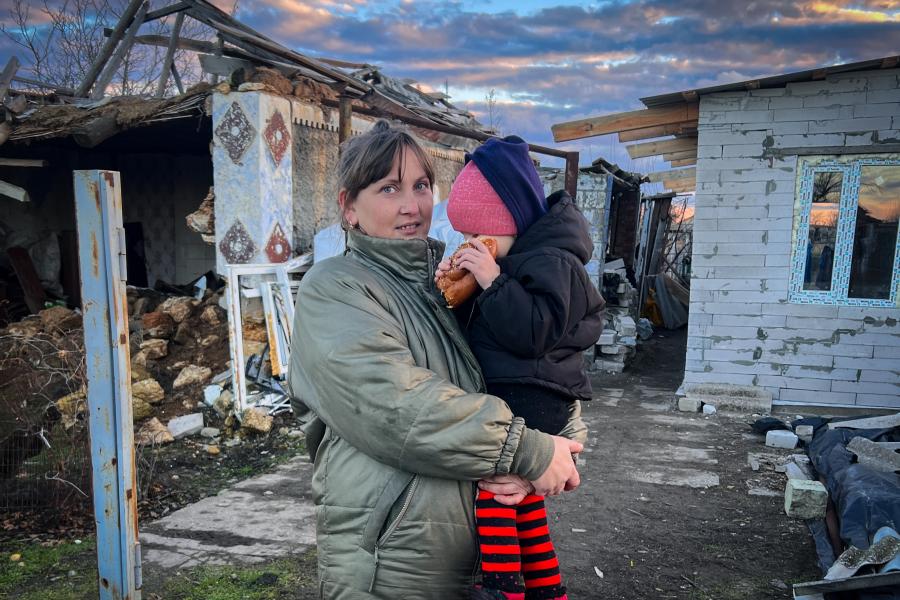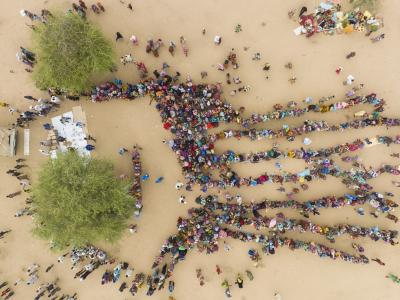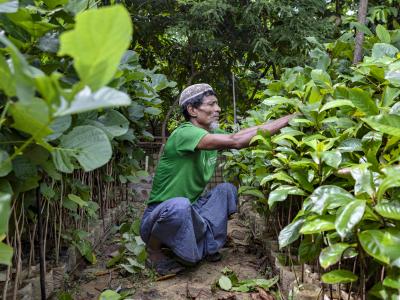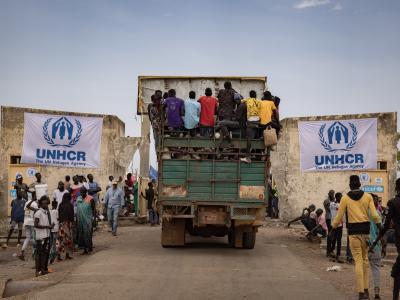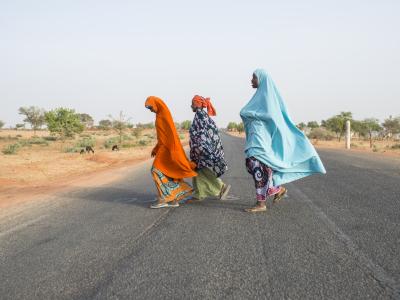Over the past two decades, internally displaced people (IDPs) have comprised the largest demographic among the world's forcibly displaced population. 63.3 million individuals were displaced within their own countries as a consequence of conflicts and violence at the end of 2023, a 10% increase from 2022.
UNHCR was engaged in situations of internal displacement in some 30-plus countries during the year, working to safeguard the rights and guarantees to prevent arbitrary displacement, ensuring protection and assistance, and finding solutions. UNHCR combined this operational engagement with its cluster lead role in protection, camp coordination and camp management (CCCM), and shelter.
UNHCR continued to prioritize cash-based interventions as the preferred modality of assistance and a critical protection tool, including in emergencies. Overall, UNHCR disbursed $305 million to over 2 million IDPs in 2023.
UNHCR co-led the Inter-Agency Standing Committee Task Force on the centrality of protection together with InterAction, and made efforts to ensure protection was prioritized and leadership accountability strengthened in humanitarian responses. 21 protection analysis updates in 18 countries were prepared by the UNHCR-led Global Protection Cluster and shared with affected States, UN Resident Coordinators and country teams, and IDPs themselves. Accountability to Affected People (AAP) and IDP participation remained a global priority. For example, UNHCR supported the involvement of young internally displaced people, alongside refugees and stateless people, from nine countries in the creation of the regional Youth in Mobility Network in the Americas, and the participation of IDPs and IDP returnees in the permanent constitution and election process in South Sudan.
Together with the Special Rapporteur on the Human Rights of IDPs, UNHCR co-led the IDP Protection Expert Group (IPEG), providing senior-level support to UN and government officials on protection challenges through country visits, including to Ukraine in 2023, and advocacy and communications, including an online event for the 25th anniversary of the Guiding Principles.
UNHCR encouraged governments to adopt IDP policies and laws that would support protection, solutions, inclusion in national services, and socioeconomic opportunities. Honduras and Chad adopted IDP laws, and UNHCR supported awareness-raising and implementation in both countries, as well as in Niger, which became Africa’s first country with an IDP law in 2018. UNHCR also conducted technical support missions on law and policy in Guatemala, Iraq and Mozambique. UNHCR contributed to positive reforms in the legislative and policy framework in countries such as Burkina Faso, Colombia, Ethiopia, Mexico, Mozambique, Nigeria and Ukraine. In collaboration with the Special Rapporteur, IPEG and the International Institute of Humanitarian Law , UNHCR organized a cross-regional forum on “Implementing laws and policies on internal displacement", involving nine governments facing internal displacement, and supported a peer-to-peer regional exchange on national IDP responses for Latin American governments belonging to the MIRPS Working Group on Internal Displacement in Colombia.
The new “Policy on emergency preparedness and response” issued in 2023 strengthens UNHCR’s response to emergencies including situations of internal displacement. The policy is in line with the 2019 “Policy on UNHCR’s engagement in situations of internal displacement” and anchors the pursuit of durable solutions from the start of a crisis, through an emphasis on the primary responsibility of authorities and the critical role communities themselves play, among others.
UNHCR was immediately able to put the new Policy on emergency preparedness and response into action when conflict erupted in Sudan in April 2023, and it rapidly moved to shore up communities’ capacity and self-reliance.
UNHCR reached over 1.7 million people including IDPs, refugees and asylum-seekers and host community members with a multi-sector response. By the end of the year, there were 9.1 million Sudanese IDPs, an increase of 5.5 million in 12 months. UNHCR scaled up its operational response for IDPs, exercised its leadership of clusters in the IASC framework, and reactivated the Camp Coordination and Camp Management Cluster. As part of its efforts to strengthen community-based protection, UNHCR supported and partnered with an IDP-led organization for a project on economic empowerment of women and social cohesion. UNHCR supported 11,000 IDP households with cash assistance, and 220,000 IDPs with non-food items and shelter assistance.
The second largest increase in IDP numbers in 2023 was in Myanmar, where an escalation in the conflict triggered over 600,000 new internal displacements in a two-month period, and UNHCR advocated for meaningful humanitarian access. By the end of 2023, over 2.6 million people were internally displaced, a rise of 1.1 million from a year earlier. Of this figure, UNHCR was able to assist 567,000 IDPs. As part of the wider response in Myanmar, UNHCR delivered core relief items to more than 120,000 families, cash assistance to 14,000 families and shelter assistance to 45,700 families.
The Syrian Arab Republic also saw internal displacement rise. An increase of over 467,000, especially in areas most affected by major earthquakes in February 2023, left it with the world’s second largest internally displaced population, at over 7.2 million. Humanitarian needs were intensified by both the earthquakes and an escalation of conflict in some parts of Syria, while deteriorating economic conditions caused the further collapse of many basic services and shortages of basic commodities. UNHCR reached over 311,000 people with protection interventions in 2023, disbursed cash to 111,000 IDPs, and assisted more than 680,000 people with core relief items, including those affected by the earthquake.
In Ukraine, UNHCR expanded its support to community-based organizations, backing some 190 projects with small and mini-grants and promoting IDP councils as consultative and advisory boards at the local authorities, so that IDPs could participate in public affairs. Almost 3.7 million Ukrainians ended the year displaced within their own country, a reduction of 2.2 million since the end of 2022. UNHCR reached 2.63 million people with crucial protection and assistance, including protection information and counselling. Furthermore, some 900,000 individuals received cash assistance, with a priority given to life-saving humanitarian assistance, and 250,000 people were provided with emergency shelter, durable housing, and accommodation. UNHCR promoted a “durable solutions from the start” approach and supported area-based approaches to solutions.
Another country with a decline in its IDP population was Mozambique, which has faced large-scale internal displacement caused by armed conflict and weathered severe climate-related shocks. By the end of 2023, 583,000 people remained displaced internally, 446,000 fewer than a year earlier. UNHCR scaled up its partnerships with development actors to mobilize their support. Projects such as those funded by GIZ and the African Development Bank supported IDPs with access to energy and services, livelihood opportunities and documentation.
In Afghanistan, the humanitarian, socioeconomic and human rights situation remained volatile, aggravated by natural disasters and a large number of returns from neighbouring countries. 3.2 million Afghans remained internally displaced, with only 31,600 able to return to their areas of origin during the year, a fraction of the 1.5 million who have returned since 2021. UNHCR’s area-based initiatives improved access to basic services and infrastructure in areas where IDPs and Afghan refugees have returned to, in concert with UNDP’s work on economic recovery, social cohesion, and resilience building. UNHCR acted to protect and assist the affected population – strengthening their resilience, encouraging peaceful co-existence, providing legal assistance, and providing cash and in-kind assistance, as well as supporting community-based interventions. Some 220,000 IDPs and IDP returnees received cash assistance from UNHCR throughout 2023.
Colombia, at the centre of multiple and overlapping displacement, saw a small increase in its substantial IDP population, with 6.9 million IDPs affected by internal conflict at year-end. At national and local levels, UNHCR supported the Colombian institutional response by fostering a network of protection actors, applying an area-based approach, and prioritizing the legalization of informal settlements with high concentrations of IDPs. UNHCR and its partners made over 2 million direct and indirect interventions benefiting the displaced population, including IDPs.
In Nigeria’s Adamawa State, an innovative Government-led, UNHCR-supported, area-based pilot project aimed to help people integrate or reintegrate into their area of residence and to prevent further displacement by ensuring access to permanent housing, tenure security, economic opportunities (through a partnership with FAO) and inclusion in Government services.
In Iraq, UNHCR worked closely with the Government to help thousands of people obtain civil documentation, key to accessing basic public services and mitigating protection risks such as restricted freedom of movement. UNHCR worked with the authorities to find dignified durable solutions for IDPs in camps, and successfully advocated for the assessment of all IDPs residing in camps to review their eligibility to be included in the Social Safety Nets of the Iraq Ministry of Labour and Social Affairs. IDPs who meet the Ministry’s vulnerability criteria now benefit from monthly cash payments that help them meet their basic needs.
In Yemen, UNHCR provided cash assistance to nearly 600,000 people, provided legal assistance, and supported more than 12,000 individuals to obtain identity documents. It also promoted livelihood activities and technical and vocational education, aiding displaced individuals to integrate and coexist peacefully with local communities. Through inter-agency coordination mechanisms, UNHCR advocated for and supported programmes on coordinated mine victim assistance, site planning, and housing, land, and property. Additionally, it supported community engagement efforts, resulting in an increased number of IDP women participating in community structures. Protection monitoring, socioeconomic assessments, and referrals reached more than 860,000 IDPs and host community members.
UNHCR implemented the United Nations Secretary-General’s Action Agenda on Internal Displacement in 15 pilot countries in Asia, the Middle East, Africa and the Americas, and supported the work of the Special Adviser on Solutions to Internal Displacement, by seconding three staff to his Office and supporting the Office of the Resident Coordinator in Yemen to advance the national solutions strategy there. UNHCR published its “Institutional plan on solutions to internal displacement”, reinforcing internal capacities, strategic partnerships, and initiatives in furtherance of IDP solutions.
UNHCR promoted the primary responsibility of States and helped bolster the solutions effort by supporting UN Resident Coordinators in promoting government-led and owned protection-oriented solutions strategies and/or co-led or chaired working groups on durable solutions at national and sub-national levels in countries such as Central African Republic, Colombia, Ethiopia, Somalia, Mozambique, Chad, Nigeria, South Sudan and Ukraine. In 2023, 5.1 million IDPs returned to their places of origin worldwide.
UNHCR continued efforts to strengthen national statistical systems, including working closely with the Joint Internal Displacement Profiling Service (JIPS), the Expert group on Refugee, IDP and Statelessness statistics (EGRISS) and regional bodies such as ECLAC in Latin America and STATAFRIC in East Africa. Specialized training programmes, such as the Collaborative Leadership Programme organized by JIPS, technical support missions like those in Mexico, Azerbaijan and Somalia co-organized by JIPS and UNHCR, and stronger collaboration with existing capacity-building programmes on forced displacement, including with Statistics Norway and Statistics Sweden, further facilitated coordinated efforts towards durable solutions for internal displacement.
To help national and local authorities achieve real change and bring solutions within reach, UNHCR collaborates across the UN system and beyond. UNHCR's “Strategy on engaging with development actors”, launched in 2023, works to deepen engagement with development actors in support of addressing displacement and laying the ground for solutions. The World Bank-UNHCR Joint Data Center on Forced Displacement (JDC) was instrumental in generating data and evidence for solutions by increasing the quality and quality of socioeconomic data and analysis. The JDC supported the CAR’s National Statistical Office to include IDPs in its national survey of living conditions, to ensure that data on IDPs was made available for development policy and planning. The survey formed the basis for a poverty assessment, which was published. Committed to strengthening collaboration across the humanitarian, development, and peace nexus, UNHCR and UN partners supported IDPs, other forcibly displaced and host communities with financing from the UN Secretary-General's Peacebuilding Fund in Cameroon, Sudan and South Sudan.

Evaluation of UNHCR’s engagement in situation of internal displacement
Completed at the end of 2023, an independent evaluation of UNHCR's engagement in situations of internal displacement proposed eight recommendations aimed at strengthening UNHCR's strategic positioning, leadership role, and operational approach in IDP settings. This included leveraging its comparative advantage and expertise in protection, establishing clear and equitable resource allocation practices, and prioritizing impactful interventions. It also emphasized the importance of defining UNHCR's role in durable solutions for IDPs and improving methods for tracking results and building staff capacity.
Additionally, the report called for better collaboration with governments, local organizations, and other stakeholders, alongside more effective resource mobilization strategies. The management response to the evaluation will be completed in 2024.
The Global Clusters
To help design proactive responses with coherence and complementarity between life-saving, development, and peace interventions, UNHCR and FAO co-led the development of the IASC guidance note on “Advancing the humanitarian-development-peace nexus approach through IASC global clusters”.



The Global Protection Cluster (GPC), with UNHCR serving as the lead Agency, is network of protection partners and allies that coordinate for a strengthened response to protection risks across humanitarian crises, including situations of armed conflict and disaster. In 2023, the GPC focused on strengthening support to country-level Protection Clusters, which were activated in 31 crisis contexts. UNHCR leads or co-leads 29 of the 31, including in Cameroon, Colombia, Ethiopia, Myanmar and Sudan, with a focus on shared protection analysis, collaborative protection advocacy and joined up protection response aimed at responding to the most severe protection risks. Following the recommendations of a 2022 IASC Protection Policy Review, the cluster focused on optimization and coherence. The GPC’s annual Global Protection Forum brought together over 2,100 participants from 143 countries. The GPC and UNHCR jointly published “The centrality of protection in humanitarian action 2022”, analysing the centrality of protection in crises where the humanitarian cluster system is activated.
The Global Shelter Cluster (GSC) reached 20 million people in need through more than 1,100 partners globally. UNHCR led 15 of the 31 active country clusters. The GSC supports country clusters for effective and impactful coordination, information management and advocacy. Key priorities included reducing the environmental impact of humanitarian shelter responses, localization, advancing recovery and durable shelter solutions and advocating for integrated approaches, which were also key themes for the GSC's annual event. To improve evidence-based decision-making on shelter interventions, the GSC launched the shelter severity classification system.
The Camp Coordination and Camp Management (CCCM) Cluster operates in 26 countries, with UNHCR leading or co-leading 18. The Cluster planned to reach 20 million individuals residing in IDP sites or various forms of informal collective accommodation in 2023. Prioritizing localization, CCCM collaborates with 161 national partners and facilitates multi-stakeholder consultations on localization in partnership with the Humanitarian Advisory Group. To bolster community involvement, CCCM ensures that its Community Engagement Forum efforts foster interaction with and within displaced communities, and it launched a new network platform among CCCM personnel and other humanitarian actors.
Financial overview
Global expenditure and budget
$1.019 billion spent against a budget of $2.099 billion
$1.081 billion of unmet needs or 51% of the budget
